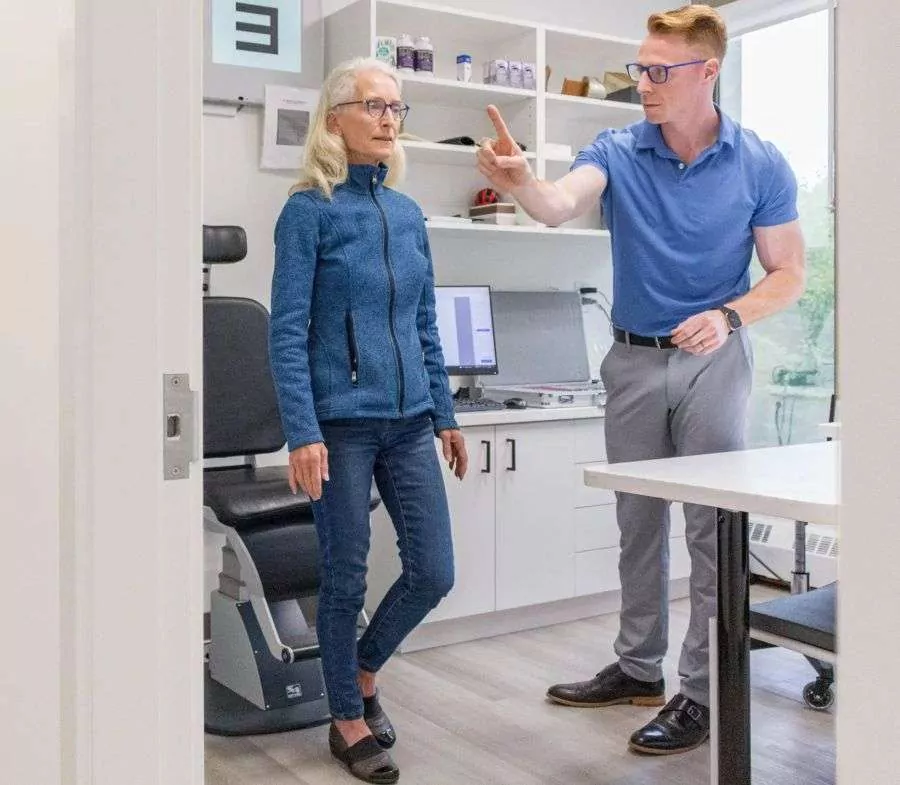Post-Trauma Vision Syndrome

What is Post Trauma Vision Syndrome?
Post Trauma Vision Syndrome is caused by damage to regions of the brain that are involved in various aspects of visual function. This disrupts the stored “programs” for how the visual system functions.
This damage occurs on the axonal level and often escapes detection by medical imaging. PTVS encompasses more specific diagnoses like egocentric visual midline shift, oculomotor dysfunction, binocular dysfunction and more.
Problems with inaccurate eye tracking may cause you to mix up the information, or feel like you struggle to comprehend it. It has been common to think about “vision” as just seeing clearly and the physiological health of the eye itself, with almost no attention given to how accurately or efficiently the system works.
The paradigm is now shifting as we understand the importance of the neurological role in eye coordination and information processing, which parallels the changes in vestibular (inner ear) understanding during the last few decades. With over 50 percent of the brain involved in visual function, PTVS is commonly responsible for ongoing symptoms after trauma.
What are the symptoms of Post Trauma Vision Syndrome?
Post Trauma Vision Syndrome (PTVS) can affect various visual functions, leading to difficulties in reading, comprehension, and sustained attention, as well as causing dizziness, vertigo, headaches, and migraines.
Reading: PTVS disrupts eye tracking and coordination, impacting reading ability and comprehension. This difficulty can be compared to a marathon runner struggling due to leg coordination issues.
Dizziness/Balance/Vertigo: PTVS disrupts the integration of visual, vestibular, and proprioceptive information, often hindering vestibular rehabilitation. Corrective lenses can improve balance and symptoms immediately.
Headaches/Migraines: Vision dysfunction after an injury can lead to headaches and migraines triggered by visual tasks. High-contrast tests can determine if the visual system is contributing to these symptoms.
Other Areas: PTVS may cause issues with tracking moving objects, making stationary objects appear to move. It can lead to general fogginess, difficulty concentrating, light sensitivity, and sensitivity to sound, as the brain struggles to process visual information effectively.
How is Post Trauma Vision Syndrome treated?
Similar to vestibular problems after a concussion, PTVS requires rehabilitative efforts centered around re-establishing the areas of affected visual function. Particular types of prescription lenses can improve the efficiency of visual function and how an individual processes depth and space. Treatment time can range from weeks to more than a year, and the neurological changes are permanent. Treatment for PTVS is commonly coordinated with other professionals.
Most eye examinations concentrate on acuity and the physical health of the eye. It is important that you ask your eye care professional if they can test for Post Trauma Vision Syndrome and the specific areas of visual function commonly affected.
For Medical Professionals
Post Trauma Vision Syndrome (PTVS) is the most common visual sequel of mild Traumatic Brain Injury (mTBI)1. While termed mild, the symptoms and impact on life can be anything but. MTBI includes concussions, minor head trauma, minor head injury, whiplash, and more. Frustratingly, our current limitations in imaging most often mean that nothing is seen on a CT Scan or MRI2. Unresolved post trauma vision syndrome will significantly impede the therapeutic processes provided by occupational therapists and physical therapists.
Conditions & Symptoms
PTVS is a constellation of signs and symptoms that may include:
Conditions:
- Problems with the focusing mechanism (accommodation)
- Tracking (ocular motor function)
- Delayed visual memory/processing
- Convergence (how the eyes come together),
- Visual spatial distortions (visual-vestibular) along with associated neuro-motor (visual-motor output) deficits.
Common Symptoms:
- Poor balance
- Headaches/migraines
- Inability to concentrate (reading/computer or even conversation)
- Dizziness/nausea
- Inability to tolerate crowded or busy places
- Disorientation
- Fatigue
- Delayed visual memory
- Many of these symptoms are seen in Post Concussion Syndrome.
Condition Specifics
Ocular Motor Dysfunction (saccade or pursuit dysfunction)
Ocular motor dysfunction (oculomotor dysfunction) refers to inaccurate tracking of the eyes. This can happen at a level of being unable to track from finger to finger, or being unable to track accurately through targets on a page. ‘Although there may be full ocular movements and no limitations in gaze, there may still be significant impairment to optimal ocular motor function regarding accuracy and speed of eye movements.’2Accurate reaching (eye-hand), navigating through space, and reading require speed and accuracy of eye movements, and will be compromised if ocular motor dysfunction persists.3,4-8Unresolved ocular motor disturbance will significantly impeded the therapeutic processes provided by both occupational and physical therapists.2
Binocular Vision Dysfunction
Problems with binocular vision are common secondary to ABI2,9-13. Binocular dysfunction refers to an inability to accurately use the two eyes together. There are varying levels, and many cases will pass ‘routine’ eye testing. They can be severely disabling to a person’s ability and performance in many activities of daily living2. Some of the affected areas include posture, balance, ability to move through space, reading, driving, playing sports. Binocular dysfunction can cause many negative symptoms such as headaches, dizziness and inability to sustain focus. Unresolved binocular disturbances will also significantly impede the therapeutic process of both occupational and physical therapists. 2
Visual Vestibular Mismatch
Central vestibular processing relies on input from the visual system. If the visual system is not accurately processing movement and spatial information, the information it gives the vestibular system will result in vestibular type symptoms. The visual conditions will impede vestibular rehabilitation therapy because the visual system will continue to interfere. Symptoms can include dizziness, nausea and balance problems.
Convergence Excess
Convergence Excess means that the eyes cross over each other too much when doing a near task. This can cause many symptoms such as headaches, dizziness, nausea, reduced reading speed/comprehension and more.
Accommodative Dysfunction
Insufficiency of accommodation is common after brain injury, even with young people9, 17It refers to the inability or inaccuracy of the brain to control where the lens of the eye is focused, or the inability to accurately change the focus of the lens within normal ranges. Symptoms can include things such as blurred print, difficulty reading, and headaches.
Visual Midline Shift
A visual midline shift represents a problem with egocentric localization2. This relates to a poor visual understanding of where objects in space are relative to ones self. Most simply put, an inaccurate understanding of where straight ahead is.14-16 Symptoms can include veering when walking, inaccurate hand-eye coordination and more.

Top 3 Reasons Patients Choose Us
For most patients, these symptoms are temporary. However, understanding the potential for these issues is important when discussing lens options with your surgeon.
Dizziness and balance issues that stem from visual problems can be significantly mitigated through our dual-faceted treatment approach.
Whether you’ve experienced a recent brain injury or have lingering symptoms from past trauma, it’s crucial to seek evaluation from a neuro-optometrist promptly. Early intervention maximizes the potential for recovery, but even long-standing conditions can find relief with our tailored treatment strategies.
Personalized Vision Therapy & Functional Evaluations for PTVS
If you or a loved one is experiencing any symptoms of double vision, dizziness or feeling off-balance, contact us for a consultation. Even if you’ve been told that your symptoms are stress-related, seasonal, or will fade on their own, having a functional visual evaluation can help rule out vision as the root cause or contributing factor to your symptoms.
It’s also important to note that not every optometrist is trained in this specialized field. Only a neuro-optometrist should assess and treat a post-TBI patient with neuro-optometric rehabilitation therapy.
How Long Does Treatment Take?
No two patients are alike — if you’ve seen one head injury, you’ve seen one head injury. Each person experiences a unique degree of dizziness, balance issues, or vision problems. Some patients may require just a few weeks of treatment, while others may need something more long-term. The good news is that the improvements achieved by neuro-optometric rehabilitation therapy are generally long-lasting.